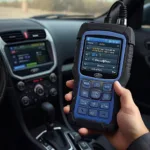If your 2017 Alfa Romeo Giulia’s OBD2 system shows “not ready” status, this article is for you. We’ll explore the reasons why your Giulia’s OBD2 system might not be ready and provide practical solutions to fix it. Understanding this system is crucial for maintaining your vehicle’s performance and emissions.
Understanding the “Not Ready” Status on Your 2017 Alfa Romeo Giulia
The “not ready” status indicates that one or more of your Giulia’s onboard diagnostic monitors haven’t completed their self-tests. These monitors continuously assess various systems, including emissions, catalytic converter, oxygen sensors, and evaporative system. When a monitor hasn’t completed its diagnostic cycle, it’s flagged as “not ready.” This can prevent you from passing emissions tests and can sometimes mask underlying vehicle issues.
Common Causes of OBD2 Not Ready Status in a 2017 Alfa Romeo Giulia
Several factors can cause a “not ready” status in a 2017 Alfa Romeo Giulia. These include:
- Recent Battery Disconnection or Replacement: Disconnecting the battery resets the OBD2 system, requiring the monitors to run their tests again.
- Cleared Diagnostic Trouble Codes (DTCs): Clearing codes using an OBD2 scanner resets the monitors, similar to a battery disconnect.
- Faulty Sensors or Components: A malfunctioning sensor or component can prevent a monitor from completing its self-test.
- Incomplete Drive Cycle: Each monitor requires specific driving conditions to complete its tests. If these conditions haven’t been met, the monitor will remain “not ready.”
- Software Issues: In rare cases, software glitches within the vehicle’s computer can affect the OBD2 system.
How to Fix the “2017 Alfa Romeo Giulia OBD2 Not Ready” Issue
Addressing the “not ready” status involves identifying the underlying cause and taking appropriate action:
- Check for DTCs: Use an OBD2 scanner to check for any stored diagnostic trouble codes. Address these codes first, as they may be preventing the monitors from running.
- Complete a Drive Cycle: Perform a specific driving pattern that allows the monitors to complete their tests. This typically involves a mix of city and highway driving, including periods of acceleration, deceleration, and idling. Consult your owner’s manual or an online resource for the correct drive cycle for your 2017 Alfa Romeo Giulia.
- Check Battery Voltage: Ensure your battery is fully charged and maintains a stable voltage. A weak battery can disrupt the OBD2 system.
- Inspect Sensors and Components: If you suspect a faulty sensor or component, have it checked by a qualified mechanic.
- Seek Professional Help: If you’ve tried the above steps and the issue persists, it’s best to consult a qualified Alfa Romeo technician who can diagnose and resolve the problem using specialized diagnostic equipment.
Importance of Addressing the OBD2 Not Ready Status
Ignoring a “not ready” status can lead to several problems:
- Failed Emissions Tests: You won’t be able to pass an emissions test if your OBD2 system isn’t ready.
- Hidden Vehicle Problems: The “not ready” status can mask underlying issues that could worsen over time.
- Reduced Fuel Efficiency: Malfunctioning systems can lead to decreased fuel economy.
“Addressing OBD2 ‘not ready’ issues promptly ensures your Giulia runs smoothly and efficiently,” says Michael Stevenson, a certified ASE Master Technician with over 20 years of experience working on European vehicles.
Tips for Maintaining Your 2017 Alfa Romeo Giulia’s OBD2 System
- Regularly check your OBD2 system using a scanner.
- Address any DTCs promptly.
- Ensure your battery is in good condition.
- Follow the recommended maintenance schedule for your vehicle.
Conclusion
A “2017 alfa romeo giulia obd2 not ready” status isn’t something to ignore. By understanding the causes and solutions, you can ensure your Giulia stays in top condition and passes emissions tests without a hitch. Regular maintenance and prompt attention to any warning signs are key to a healthy OBD2 system and a smoothly running vehicle.
FAQ
- What is an OBD2 drive cycle? A specific driving pattern designed to allow the OBD2 monitors to complete their self-tests.
- How long does an OBD2 drive cycle take? It varies depending on the vehicle and the specific monitor, but it generally takes between 30 minutes to an hour.
- Can I complete an OBD2 drive cycle myself? Yes, you can typically complete a drive cycle by following specific driving instructions.
- Will disconnecting the battery fix the “not ready” status? No, it will reset the monitors and require you to complete a drive cycle.
- What does a flashing check engine light mean? A flashing check engine light indicates a serious problem that requires immediate attention.
Need support? Contact us via WhatsApp: +1(641)206-8880, Email: [email protected]. We have a 24/7 customer support team.
